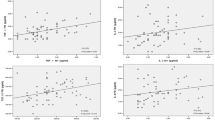Abstract.
Purpose: To investigate the transforming growth factor β2 (TGF-β2) levels and total protein levels in the aqueous humor of eyes with different types of glaucoma [primary open-angle glaucoma (POAG), pseudoexfoliation glaucoma (PSX), juvenile glaucoma (JG)], and the relation to filtering bleb development after trabeculectomy. Methods: Aqueous humor was collected at the beginning of surgery from 52 eyes with glaucoma (29 POAG eyes, 17 PSX eyes, 6 JG eyes) and from 29 control eyes that underwent cataract operation. TGF-β2 levels (intrinsically activated and total TGF-β2 ) using ELISA methods as well as total protein concentrations of the aqueous humor were determined. All preoperative clinical data of the glaucoma eyes (age, gender, IOP, previous treatment, type of surgery) were compared with the TGF-β2 levels. In 40 of these eyes, the postoperative follow-up (filtering bleb development, need for intervention, IOP) was correlated to the preoperatively determined TGF-β2 levels. Results: TGF-β2 levels were increased in nearly half of the eyes with POAG and in most of the eyes with JG, but in eyes with PSX, TGF-β2 levels were within the normal range. No correlation between TGF-β2 levels and age, gender, IOP, previous treatment, or type of surgery, or between TGF-β2 levels and protein levels in aqueous humor, was found. Correlation between bleb formation and TGF-β2 levels revealed that all but two of the POAG eyes with good clinical outcome (type 1 bleb) had normal levels of activated TGF-β2. Of the 13 eyes that needed postoperative intervention (type 2 and type 3 bleb), 8 had high and 5 had normal TGF-β2 levels. Conclusions: PSX eyes differ from POAG and JG eyes not only by their clinical or biomicroscopic appearance, but also by their normal TGF-β2 levels in aqueous humor. The fact that most of the POAG eyes with favorable bleb development had normal TGF-β2 levels indicated that there might be some relationship between bleb formation and TGF-β2 levels. On the other hand, the fact that eyes with less favorable bleb development had both low and high TGF-β2 levels indicated that other factors are also involved in the scarring of the filtration bleb.
Similar content being viewed by others
Author information
Authors and Affiliations
Additional information
Electronic Publication
Rights and permissions
About this article
Cite this article
Picht, .G., Welge-Luessen, .U., Grehn, .F. et al. Transforming growth factor β2 levels in the aqueous humor in different types of glaucoma and the relation to filtering bleb development. Graefe's Arch Clin Exp Ophthalmol 239, 199–207 (2001). https://doi.org/10.1007/s004170000252
Received:
Revised:
Accepted:
Issue Date:
DOI: https://doi.org/10.1007/s004170000252




